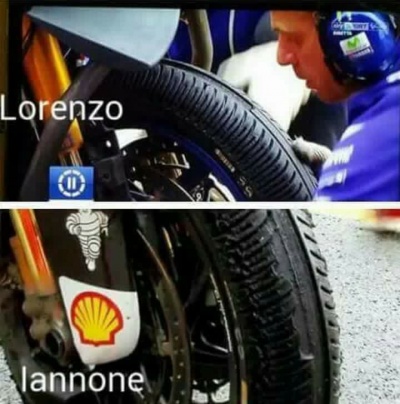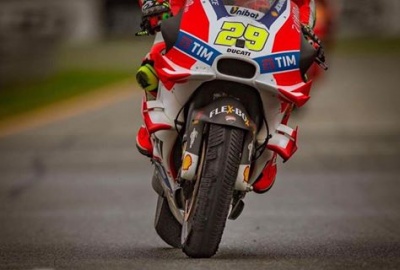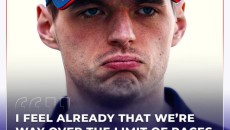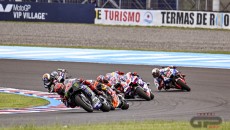The Grand Prix of the Czech Republic, along with many other of this season's races, was all about the tyres.
To a greater extent than that of Argentina, or Holland, and it's left us with some lingering doubts.
Questions that everyone should be asking, particularly Race Direction, considering that it has been able to analyse corner exit during practice sessions down to the last centimetre, eliminating lap times as a result and yet, at the same time, fails to note extremely dangerous situations such as those seen during the MotoGP race at Brno.
Yes, because allowing riders to continue the race with a semi-destroyed front tyre that could explode from one moment to the next is simply criminal.
 UNACCEPTABLE RISK - While Dovizioso and Lorenzo immediately returned to the garage as soon as their front tyres started to disintegrate, others such as Iannone continued with a vengeance.
UNACCEPTABLE RISK - While Dovizioso and Lorenzo immediately returned to the garage as soon as their front tyres started to disintegrate, others such as Iannone continued with a vengeance.
Full respect to him, and his courage of course, but what would have happened if the Maniac had lost control of his Ducati in braking?
"Sometimes that happens to him even with good tyres", joked Lin Jarvis of Yamaha.
BLACK FLAG - The black flag exists precisely for cases like this. Race Direction is obliged to stop a rider when it becomes clear that something on his bike could endanger his life or that of other riders.
In the past this often happened, because the two-strokes had the bad habit of breaking the expansion tanks which would sway dangerously. Today it rarely happens, but Sunday was one of those cases where RD should have intervened.
 BUT IS THERE A RACE DIRECTION? - A good question, because if we talk about safety, we must always do so, without leaving room for too much interpretation.
BUT IS THERE A RACE DIRECTION? - A good question, because if we talk about safety, we must always do so, without leaving room for too much interpretation.
Let's take the spoilers for example.
Even there is no evidence to support the fact, they will be banned from next year because they are deemed dangerous.
You might ask why they are not banned with immediate effect but here the reply is obvious: to avoid doing wrong by those who have adopted them and invested in them.
This is correct, changes should not be made to current rules in force.
OBLIGATORY HELMET, WHY NOT NOW? - But in another case - making it obligatory for mechanics to wear a protective helmet during the flag-to-flag - where is the logic in not immediately adopting the new regulation?
"It will be a good reason to find sponsorship with a helmet company, or that's what we'll try to do at least", said a smiling Lin Jarvis.
But Yamaha, and the others teams, would obviously have no problems buying ten helmets ahead of the next Silverstone Grand Prix.
Because the danger - that the mechanic slips and suffers a head injury - already exists today, while there is no reason not to implement the new rule with immediate effect.
Reasoning is required. Always. Because in the unlucky event of an accident, what is the justification for not having adopted a rule that could be very easily implemented as of the British GP?
But let's return to the tyres
THE MICHELIN GAMBLE - In Argentina Michelin recalled a tyre that it deemed unsafe.
Why did it not do the same last Sunday?
Simple: a flag-to-flag race was expected.
That is, Michelin was aware that, on a drying track, the soft solution would be no good: "That tyre is suited for use on a very wet track", read the post-race press release.
 So it was an error of judgement: Michelin trusted in the fact that the riders would swap over to slicks as soon as the track began to dry out. Which didn't happen, with the exception of Jorge Lorenzo of course, who was forced to change over.
So it was an error of judgement: Michelin trusted in the fact that the riders would swap over to slicks as soon as the track began to dry out. Which didn't happen, with the exception of Jorge Lorenzo of course, who was forced to change over.
Furthermore, there was no way to inform the riders, based on what was happening, about the possibility of returning to the garage to replace the front tyre. They all knew that, on a track that was still wet, it would have been racing suicide to move to slicks.
Perhaps radio communications aren't such a bad idea.
THE YAMAHA CASE - One last thing. While it's normal for different bikes to make different use of the tyres, meaning that we can't compare the state of Iannone's tyre with that of Rossi, in that they ride a Ducati and a Yamaha, there shouldn't however be too much difference in terms of performance between the tyres of Lorenzo and Valentino.
There is a big difference between losing pieces of the tyre and finishing the race, but this is exactly what happened at Brno.
The Spaniard was forced to stop, Rossi came second.
Let's take a closer look at the two team-mates' situations.
LAP BY LAP - On lap 11, Vale was lying 9th and Jorge 12th, on lap 13, they were positioned 7th and 11th respectively. Both were making up positions. On lap 14, another step forward, the Italian in 6th, the Spaniard 10th.
Then unexpectedly on lap 15 Rossi was holding his position while Lorenzo suddenly dropped back before entering the pits.
Can a different setting, or a different riding style, make such a difference?
The answer might lie in the fact that one of the two was pushing harder on the tyres, but before stopping, on lap 14, Vale was 4"277 from the race leader, Jorge 10"170 - the latter was actually going slower.
Please don't think there is some conspiracy going on, because there isn't, but we are only puzzled as to whether those tyres were simply unsuitable for a Grand Prix. Just like those recalled in Argentina after Scott Redding's rear tyre exploded in practice.
LOOK AT THE VIDEO








